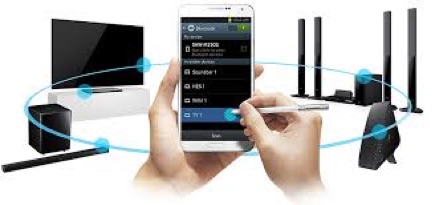HOME ENTERTAINMENT SOLUTIONS

By the time of writing in the fall of 2018, this is perhaps the area of smart homes where it is least clear where the development is headed as the product selection per se is quite large, but often not in the spirit of an integrated, smart home. Most brands within the home entertainment market have some products that allow using a smart phone/tablet/etc. to control playback and settings. In my view, this does not constitute a smart home, but rather an alternative to the classic remote control.
On this page, I will limit the presentation to the following areas:
Integration of home entertainment products into a smart home, which currently is a product category with fewer available solutions. My investigations mainly point in the direction of Logitech Harmony (with some adaptation, especially after Logitech updated the hub firmware which removed some integration possibilities, more about this under living room). Smart speakers is arguably one of the product categories that have received the most attention the last couple of years, with the launch of several versions of Amazon Echo, Google Home, and lately Apple HomePod. Even though smart phones from different manufacturers for many years have offered voice-based smart assistants, these have really taken off after these smart speakers have become a quite widespread product even in “ordinary homes”. The three products (Amazon Echo, Google Home, and Apple HomePod) offer some different features and opportunities, but the basic principle is that the speaker is always on and listening for the trigger phrase that activates it. After triggering it, commands can be used to have the assistant perform various tasks, e.g., looking up information online, ordering a product from Amazon, etc. These have little to do with smart homes, but more relevant tasks in that respect are turning on/off devices, activating scenes/programs, etc. This means you don’t have to tap your phone or other device to turn on lights, adjust the temperature, turn the home entertainment system in movie mode, etc., you can simply talk to the house. Should you find it strange to just «talk into thin air», I can reassure you that you quickly get used to this, and it is both much more efficient that opening your phone, finding the right app, and punching the right button as well as being strangely satisfying to see immediate effects of voice commands you issue.
Smart speakers with voice control, which is a category closely related to the main category of control & automation, depending on how you use such speakers. If used primarily as a wireless speaker for streaming audio from different devices through, I don’t really consider them a smart home unit, but if used for voice control of the smart home they definitely deserve presentation on this page
Other types of products that could have been included, but which I don’t really consider to be true smart home solutions:
Multi-room audio systems, which certainly do contain some advanced functionality, but don’t play a role in controlling smart home devices
Smart remote controls (dedicated devices or in the form of app for smart phone/tablet/etc.), but which to little/no extent facilitate any other integration than controlling multiple home entertainment system devices
TVs that allow coordinating/controlling other home entertainment system devices